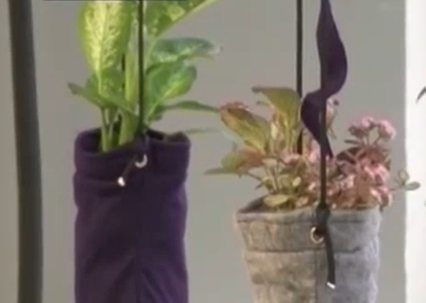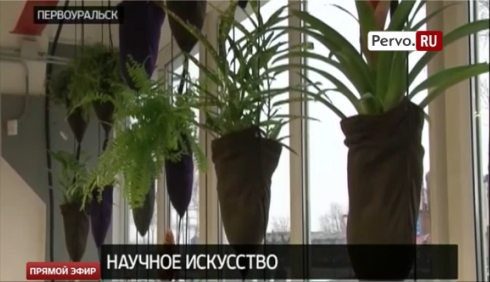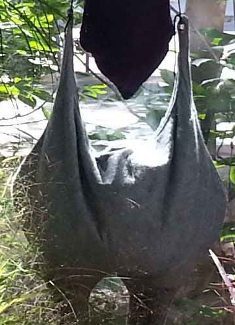Yes. Worms and hydroponics blended into one system. People have been dabbling with this for the past couple of years, but now a professor of architecture at Ohio State University has a vertical window farm design that is being tested in Russia.
Not much actual information is available beyond that. It’s a hydroponic system that incorporates vermiculture as nutrients, or a portion of them. It must work, or a permanent installation of the design wouldn’t be of interest on the other side of the world. The plants in the photo shared by OSU in their news post certainly look healthy, but there are some who question it’s validity. We all know that keeping the nutrients at the right levels is critical to hydroponic growing success, and worm compost is good, but it’s not stable in terms of the available nute levels. However, we have no clue as to what the growing medium is here.

The bags are made from what looks like felt though, so it isn’t necessarily hydroton or gravel used to contain the roots. So it is highly possible that there is some actual soil involved here. It also doesn’t appear to be a closed system. Check out the screen shots from the only video available on what is called the Cascading Garden at OSU where the original installation is housed. Unless you speak Russian, you won’t have a clue what is going on in the TV news story about the installation there.
Bags made from a material do allow air flow through the sidewalls, and if the system is not looping the nutrient solution back to the tank this could make sense. Much like a clay pot where a potting mix that includes topsoil does work well, it could be in use here. The bags look pretty heavy too, but there’s another reason to suspect that there is soil in these pouches. Where are the worms?

Notice that there are no tubing lines into the bags? Some of them have what looks like the material used to make handles for totes and other types of fabric bags running through them. I suspect this uses gravity and natural drainage action to carry moisture from the top tier to plants in the lower levels. It isn’t in all the rows though, yet there looks to be a sort of fringe on the bottoms of the columns without this strapping running through the center of the bags. This probably helps to move moisture in a targeted path, and my guess would be that the rows with the center webbing running through them are for the more water hungry plants one would grow. Watch the Russian video here – the Cascading Garden shows up soon and is only covered briefly.
Curious, isn’t it? Next take a good look at the really large version of Rinaldo’s OSU image. There is no collection tray for solution run-off. But there is a row of plants in standard patio containers down there, which no doubt catch everything that escapes the bags. There is a cold air return for the heating system in the floor under some of them.
So, where is the hydroponics solution feed? The largest flower pot on the left appears to be the nutrient or water reservoir. You can see black tubing running up the black pipe next to it to the top. Follow it across what appears to be a gutter, and you’ll see the feed lines. They are black and blend right in with the the hanging cords. But that isn’t a gutter at the top – it’s a ledge and part of the actual building, not the vertical garden.
 You can only see the very top of the Russian installation on the far left side, and as is the problem with all online video beyond Hollywood movies – it’s not super clear imagery. Still if you really look at it in full screen view there is tubing running from the ceiling to the top bags. Here instead of being hidden by a pole and a window header, the black irrigation water line is taped to the wall and continues it’s run across the top of the vertical garden. This is how the hydro system delivers moisture and nutes to the grow bags on the top, and the same action we have in the soil is how every plant below there gets what it needs. What I don’t understand is what the heck is this thing pictured to the left. It is just there. Not really hooked to anything visible, and whatever is inside is lumpy. Can’t be worm housing, as it makes no sense in this location.
You can only see the very top of the Russian installation on the far left side, and as is the problem with all online video beyond Hollywood movies – it’s not super clear imagery. Still if you really look at it in full screen view there is tubing running from the ceiling to the top bags. Here instead of being hidden by a pole and a window header, the black irrigation water line is taped to the wall and continues it’s run across the top of the vertical garden. This is how the hydro system delivers moisture and nutes to the grow bags on the top, and the same action we have in the soil is how every plant below there gets what it needs. What I don’t understand is what the heck is this thing pictured to the left. It is just there. Not really hooked to anything visible, and whatever is inside is lumpy. Can’t be worm housing, as it makes no sense in this location.
Sounds pretty crazy, doesn’t it? Yet, obviously it isn’t impossible. It works well enough that Ken Rinaldo from OSU went all the way to Russia to install it into a food sustainability project there. So why isn’t there any information about this system? We’ll probably have the facts when the patent is granted, and you can purchase it as a kit.
You could always use the available information to design your own vermiponics growing system. This isn’t quite the same as secretive vermiponic window gardens, but it is obviously working for this DIY user in Phoenix. His lettuces are looking very happy.